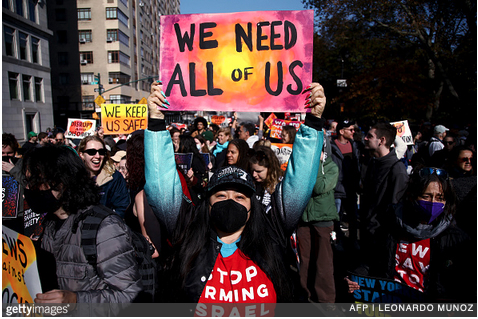By Olivia Alperstein for Institute for Policy Studies
Ahead of Tax Day, April 15, the National Priorities Project at the Institute for Policy Studies released its latest annual analysis highlighting exactly where Americans’ 2023 income taxes went and what those numbers say about our national spending priorities.
While most Americans will know whether they get a tax refund, many have no idea where their income tax dollars go. NPP’s new analysis spotlights how much of taxpayers’ money goes towards militarism and its support systems. These include the Pentagon, weaponry, militarism, war, and other security and border enforcement spending. The new “Tax Receipt” compares to how many tax dollars go toward funding vital programs with the defense spending.
Overall, in 2023, the average taxpayer contributed $5,109 for militarism and its support systems – including war and the Pentagon, veterans’ programs, deportations and border militarization, and federal spending on policing and prisons.
In 2023, the average taxpayer subsidized military corporate contractors, including:
- $1,748 toward Pentagon contractors, more than the average monthly rent in the U.S. ($1,372).
- $249 for contracts for Lockheed Martin, the largest Pentagon contractor. That’s more than a week’s food expenses for the average American household ($195).
- $87 for the Pentagon’s contracts with Boeing, the company responsible for the 737 Max’s safety failures. That’s equivalent to filling your car’s gas tank twice (based on a 12-gallon gas tank and average U.S. gas price of $3.53 per gallon on March 26, 2024.)
- $12 for the Pentagon and NASA’s contracts with SpaceX, Elon Musk’s company. That’s more than the cost of three gallons of milk.
In contrast, taxpayers’ money contributed:
- $516 for food stamps (Supplemental Nutrition Assistance Program/ SNAP), the food access program that served more than one in ten Americans at a time of rising food costs.
- $110 for the Child Tax Credit, which supports families with children and whose expansion helped cut child poverty nearly in half.
- $14 for wildfire management. Wildfires cost upward of $394 billion in damages every year.
- $10.84 for energy efficiency and renewable energy programs to combat climate change.
“It’s outrageous that the average taxpayer is giving the equivalent of a month’s rent to Pentagon contractors. These big corporations are already not paying their fair share in taxes. Instead, ordinary people are subsidizing those corporations’ profits and multi-million dollar CEO pay packages. Taxpayer dollars should be going to real needs like schools, food and housing programs, or renewable energy – not lining the pockets of corporations,” said Lindsay Koshgarian, Program Director for the National Priorities Project at the Institute for Policy Studies.
While taxpayers’ money largely funds militarism, a lot less of that money goes toward actually addressing the needs of military servicemembers and their families. The military budget is supposed to prioritize security and the troops, but too often it prioritizes profit instead. NPP’s receipt shows that the average taxpayer contributed $1,748 last year for Pentagon contracts, but that same taxpayer contributed just $705 for military troops’ pay and housing allowances. Entry-level pay for enlistment in the Army is $24,206, or the equivalent of $11.64 per hour – low enough to put many troops and their families on food stamps and other public assistance programs.
“Right now, millions of Americans are struggling to stay afloat – it’s become so expensive to live, eat, and have a home. Yet, instead of addressing the cost of living crisis or funding measures to address our communities’ needs, this year $5,109 of the average American’s taxpayer dollars went to fund the military and its support systems,” said Alliyah Lusuegro, Outreach Coordinator for the National Priorities Project at the Institute for Policy Studies. “A far greater portion of our tax dollars goes toward militarism at home and abroad, and toward harming and separating immigrant families, when we should be investing instead in safe and healthy conditions for our communities and our futures.”
View a comprehensive breakdown of key findings and the full analysis.


